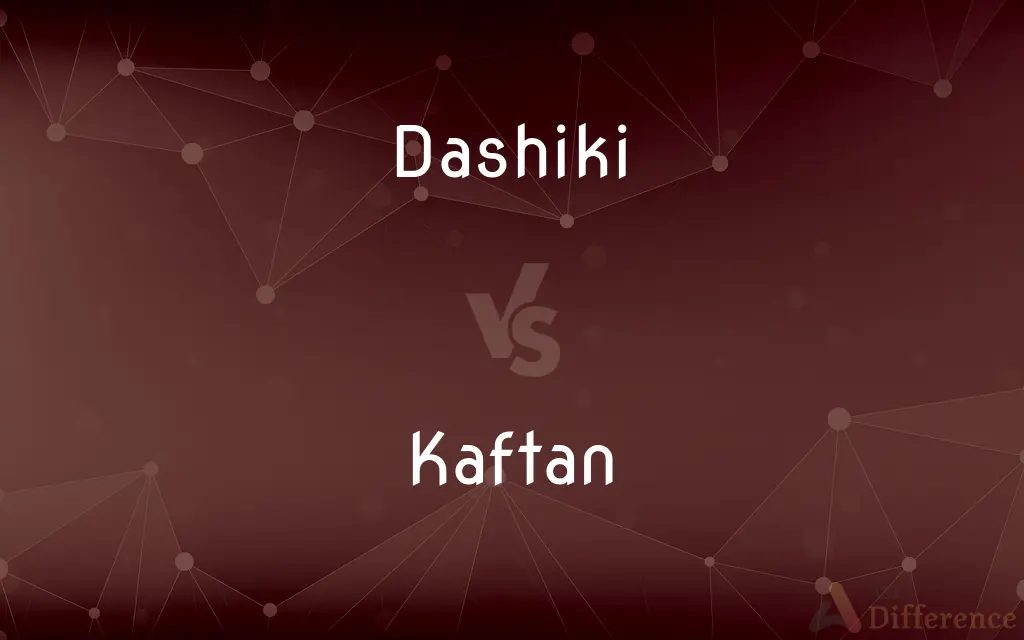Dashiki vs. Kaftan — What's the Difference?
By Maham Liaqat & Urooj Arif — Updated on March 28, 2024
Dashiki is a colorful, loose-fitting garment often worn in West Africa, emphasizing vibrant patterns, while a Kaftan is a long, flowing robe worn in various cultures, known for its comfort and versatility.

Difference Between Dashiki and Kaftan
Table of Contents
ADVERTISEMENT
Key Differences
Dashikis are known for their symbolic designs, including tribal patterns and motifs that often hold cultural significance. These garments are not just fashion statements but are deeply rooted in African history and identity. Whereas Kaftans, while they may also feature patterns and embroidery, are appreciated for their versatility and are worn in many contexts around the world, from beachwear to luxurious evening attire.
The fitting of a Dashiki is generally loose, but it is designed to be more form-fitting than a Kaftan, allowing for ease of movement while maintaining a distinctive style. Kaftans, on the other hand, are valued for their extreme comfort and flowy nature, making them ideal for various body types and sizes.
Fabric choice plays a crucial role in differentiating the two. Dashikis are often made from cotton, making them breathable and suitable for the hot African climate. Kaftans can be found in a wide range of materials, including cotton, silk, and wool, catering to different climates and occasions.
In terms of cultural significance, the Dashiki is a garment with profound meanings, often worn during Black History Month and at African festivals. The Kaftan transcends cultural boundaries, having been adopted and adapted by numerous cultures, signifying its global appeal and adaptability.
Comparison Chart
Origin
West Africa
Middle East
ADVERTISEMENT
Design
Colorful with intricate patterns and V-neck
Long, flowing robe, often with elaborate designs
Cultural Significance
Symbol of African heritage and pride
Worn across various cultures with diverse significances
Fabric
Primarily cotton
Cotton, silk, wool, among others
Versatility
Casual and formal wear
Ranges from everyday wear to luxury attire
Fit
Loose but more form-fitting than a Kaftan
Very loose and flowing
Popularity
Popular in Africa and among the African diaspora
Globally worn, transcending cultural boundaries
Compare with Definitions
Dashiki
Symbolizes cultural pride and is worn on special occasions.
She donned a Dashiki for the cultural festival, embracing her roots.
Kaftan
Versatile wear, used from casual to formal occasions.
His wool Kaftan served well against the cold, blending tradition with warmth.
Dashiki
Made predominantly of cotton for comfort in warm climates.
His cotton Dashiki was both a style statement and a relief in the summer heat.
Kaftan
A long, flowing robe often associated with Middle Eastern attire.
She chose a silk Kaftan for its elegance and comfort at the evening event.
Dashiki
A vibrant, patterned shirt originating from West Africa.
He wore a colorful Dashiki to celebrate his African heritage.
Kaftan
Embraced by many cultures for its comfort and adaptability.
The Kaftan has been adapted into local fashion, showcasing its global appeal.
Dashiki
Popular across the globe, especially in diaspora communities.
The Dashiki has gained popularity worldwide, celebrated for its beauty and cultural significance.
Kaftan
Features elaborate designs and embroidery in some styles.
The intricately embroidered Kaftan was a centerpiece at the fashion exhibit.
Dashiki
Features a loose fit and V-neck, often in bright colors.
The Dashiki’s V-neck design complements its bold patterns.
Kaftan
Comes in various fabrics, including silk and cotton.
For the beach outing, her lightweight cotton Kaftan was the perfect choice.
Dashiki
The dashiki is a colorful garment worn mostly in West Africa. It is called Kitenge in East Africa and has been a dominant wear in Tanzania and later Kenya and Somalia.
Kaftan
See Caftan.
Dashiki
A loose, brightly colored, patterned tunic worn especially in West Africa.
Kaftan
A woman's dress style that imitates the caftan cloaks worn by men in the Near East
Dashiki
A loose and brightly-colored African shirt.
Kaftan
A kaftan or caftan (; Persian: خفتان khaftān) is a variant of the robe or tunic, and has been worn in a number of cultures around the world for thousands of years and is of Asiatic origin. In Russian usage, kaftan instead refers to a style of men's long suit with tight sleeves.
Dashiki
A loose and brightly colored African shirt
Kaftan
A man's long belted tunic, worn in countries of the Near East.
Kaftan
Variant of caftan.
Kaftan
A long tunic worn in the Eastern Mediterranean.
Kaftan
A long dress or shirt similar in style to those worn in the Eastern Mediterranean.
Kaftan
A (cotton or silk) cloak with full sleeves and sash reaching down to the ankles; worn by men in the Levant
Common Curiosities
Is a Kaftan considered formal or casual wear?
A Kaftan can be both, depending on the fabric and design. Silk Kaftans may be formal, while cotton ones are more casual.
What occasions are suitable for wearing a Dashiki?
Dashikis are suitable for both casual and formal occasions, including cultural festivals and celebrations.
Do Dashikis have cultural significance?
Yes, Dashikis hold cultural significance, symbolizing African heritage and pride, especially within the African and African-American communities.
Can both men and women wear Dashikis and Kaftans?
Yes, both garments are for both genders and can be worn by men and women.
How do the designs of Dashikis and Kaftans differ?
Dashikis often feature vibrant patterns and a V-neckline, whereas Kaftans may have elaborate designs or embroidery, with a focus on a loose, flowing silhouette.
What is the main difference between a Dashiki and a Kaftan?
The main difference lies in their design and cultural origins; Dashikis are colorful, patterned garments from West Africa, while Kaftans are long, flowing robes of Middle Eastern origin.
Why are Kaftans popular in various cultures?
Kaftans are popular due to their versatility, comfort, and adaptability to different styles and climates, making them a favored choice worldwide.
Can Kaftans be worn in cold weather?
Yes, Kaftans made from heavier fabrics like wool can be suitable for cold weather.
Are Dashikis and Kaftans expensive?
The price can vary widely depending on the material, design, and where they are purchased. Handcrafted or designer pieces may be more expensive.
What fabrics are used to make Dashikis?
Dashikis are primarily made from cotton, suitable for the warm climates of West Africa.
Share Your Discovery

Previous Comparison
Orientation vs. Seminar
Next Comparison
Dubbed vs. SubbedAuthor Spotlight
Written by
Maham LiaqatCo-written by
Urooj ArifUrooj is a skilled content writer at Ask Difference, known for her exceptional ability to simplify complex topics into engaging and informative content. With a passion for research and a flair for clear, concise writing, she consistently delivers articles that resonate with our diverse audience.














































